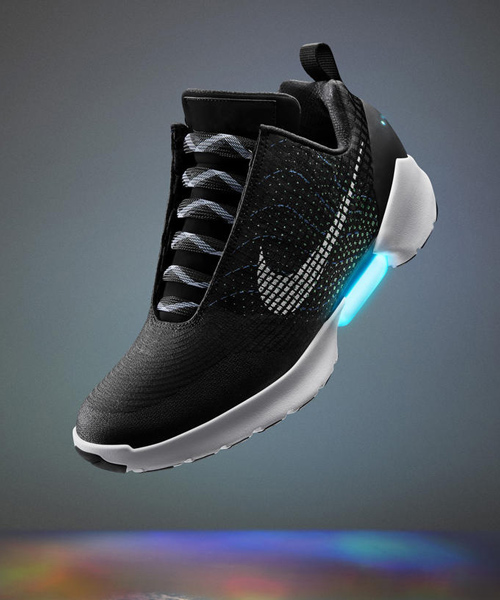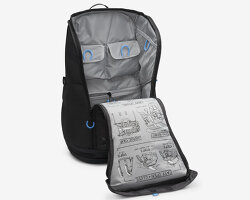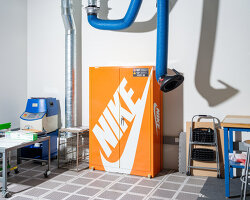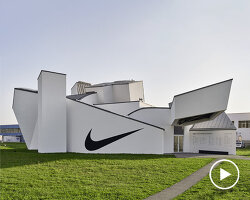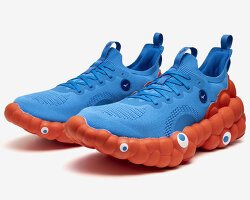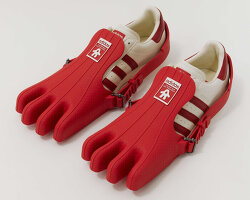HyperAdapt 1.0: NIKE unveils a sneaker that laces up at the touch of a button
NIKE has launched a pair of sneakers that feature its latest platform breakthrough: adaptive lacing. as the athlete steps into the ‘HyperAdapt 1.0’ the heel hits a sensor, prompting the built-in system to automatically respond to the wearer’s unique foot dimensions. two buttons on the side of the shoe tighten and loosen the sneaker as necessary. the product translates deep research in digital, electrical and mechanical engineering into a shoe designed for movement.
the ‘HyperAdapt’ is inspired by the footwear marty mcfly wore in the movie back to the future — shoes that renowned NIKE designer tinker hatfield conceived for the 1985 film. ‘about 25 years ago I designed a back to the future shoe that had a power lacing system, and we thought that was great for the movie, but it was just fantasy, right?’, hatfield told designboom. ‘then, roughly ten years ago, we started to realize that the motor technology, battery power, cabling systems, and our own ability to knit and weave, made us think: ‘you know what, I think we can do this’.’
introducing the NIKE ‘HyperAdapt 1.0’
in developing the product, hatfield worked alongside tiffany beers, senior innovator at NIKE. beers began investigating the shoe’s integrated mechanics shortly after meeting hatfield, who asked if she wanted to develop the concept further as a means to get to a ‘more sophisticated place’. the project then caught the attention of a third collaborator, NIKE president & CEO mark parker, who helped guide the design. the process saw beers brainstorming with a group of engineers, who originally came up with a snowboard boot featuring an external generator. this was the first of a series of strides toward the team’s original goal: ‘to embed the technical components into such a small space that the design moves with the body and absorbs the same force the athlete is facing’.
throughout 2013, hatfield and beers spearheaded a number of new systems, before arriving at an underfoot-lacing mechanism. in april 2015, beers was tasked with making a self-lacing concept to celebrate the icon’s fictional ‘back to the future’ release date of october 21, 2015. ‘it’s a platform,’ beers says, ‘something that helps envision a world in which product changes as the athlete changes.’ although the sneaker is currently manual (athlete controlled), it makes feasible — for the first time — the idea of an automated, symbiotic relationship between the foot and the shoe.
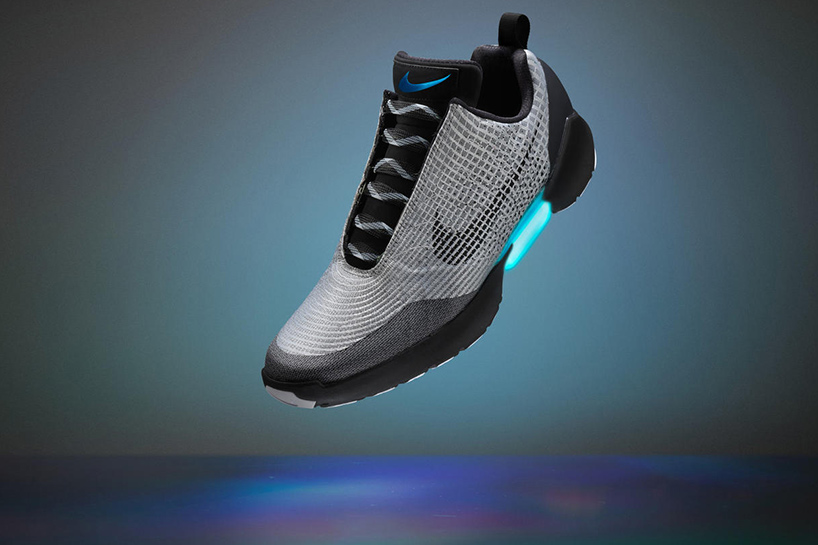
the shoe comes in three colorways: silver, white, and black
hatfield believes that the potential of adaptive lacing is huge, allowing athletes to adjust their footwear — during a game — at the touch of a button. ‘it is amazing to consider a shoe that senses what the body needs in real-time. that eliminates a multitude of distractions, including mental attrition, and thus truly benefits performance. wouldn’t it be great if a shoe, in the future, could sense when you needed to have it tighter or looser? could it take you even tighter than you’d normally go if it senses you really need extra snugness in a quick maneuver? that’s where we’re headed. in the future, product will come alive.’
the ‘HyperAdapt 1.0’ will be available exclusively to members of NIKE+, a new app that provides athletes with a personally tailored experience. see below for more information.
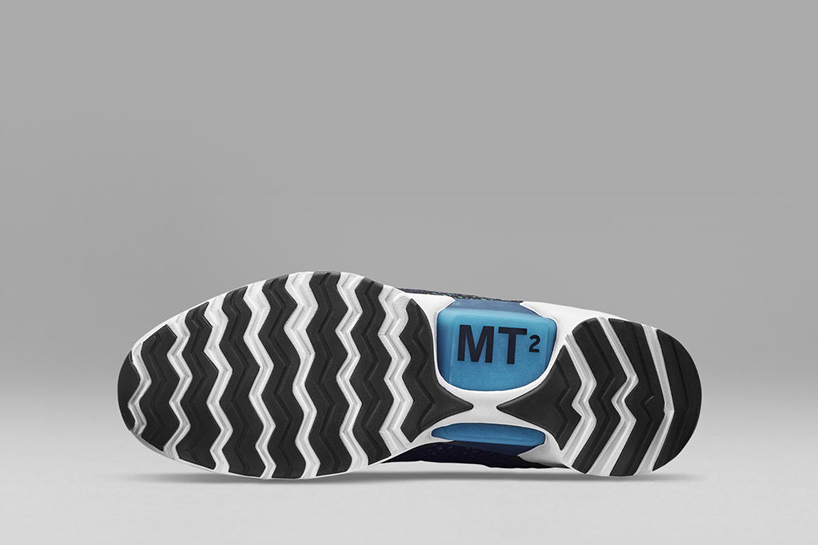
the design involved deep research in digital, electrical and mechanical engineering
to learn more about the ‘HyperAdapt 1.0’, designboom spoke with tinker hatfield — NIKE’s vice president for design and special projects. hatfield is the designer behind some of NIKE’s most popular and innovative shoes, such as the AIR MAX ONE and the AIR JORDAN range, and continues to oversee some of the brand’s biggest and best ideas.
designboom: you said that the ‘HyperAdapt’ has been a long time in development — ten years in fact. can you break that down into how the shoe has evolved over that time?
tinker hatfield: obviously, all shoes start with some kind of inspiration, and it’s fair to say that about 25 years ago I designed a ‘back to the future’ shoe that had a power lacing system. we thought that it was great for the movie, but it was just fantasy, right? then, roughly ten years ago, we started to realize that the motor technology, battery power, cabling systems, and our own ability to knit and weave, made us think: ‘you know what, I think we can do this.’
so I drew it up, and I was inspired by ‘WALL-E’, a movie about how destroyed our planet is. there’s this little robot that survived, and that robot then meets this newer one, and they kind of form a bond. it was really a nice story about the environment, but it was really a story about the future. sometimes you start a project and it’s not just about solving problems, but it’s also about creating character and storyline — just like those guys do with movies.

the product has been engineered for movement
DB: with the features that you touched upon, how do you consider the future applications for the shoe. who do you think will be using it?
TH: right now, this is a multipurpose shoe. it’s not our best basketball shoe, it’s not our best running shoe — but you can run in it, you can play basketball in it. you can do a variety of things in it. when you’re trying to develop new technology, it’s going to take a few years to put it on the best basketball players in the world. we’re working on those iterations right now, which will actually be an improvement, since every few months we see better materials and more opportunities for refinement.
so what you are going to see from us, is this first introduction in a multipurpose format. it has a little bit of a chuck taylor sneaker look where it has a white bottom and black upper — or a white one, or a silver one. the idea is to keep it sneaker-like, and not to be too crazy. having said that, the higher performing version is something that’s going to take a lot more time to come to fruition. even when somebody has been designing shoes for so long, it’s not boring when new ideas keep popping up.

for the first time, the concept of a symbiotic relationship between the foot and shoe is made feasible
DB: as the ‘HyperAdapt’ has been ten years in development, how has the actual design process changed in recent years with new technologies? has that accelerated the design of the shoe?
TH: it’s like if you’re designing automobiles or architecture. the materials change rapidly. the sensors are becoming more smart, and of course the motors and the materials are working together better. so we are trying to pay attention to what other companies are doing, and we know who we are — we are all about sports, we are all about fitness, and helping people do that. we recognize that technology can actually help people have healthier feet.
if you’re in a basketball game, half of the time you are not doing anything. you might be sitting on the bench, there might be a free throw, there might be a jump ball, there might be a time-out — a lot of standing around. wouldn’t it be great if your shoes could relax and help you get the blood-flow back to your foot, and give your foot a break? and then, when you start moving again the shoe goes instantly back into high performance. I think that there are other products that are doing that. we are seeing cars where the suspension adapts depending on how hard you’re turning, and you can make that analogy.
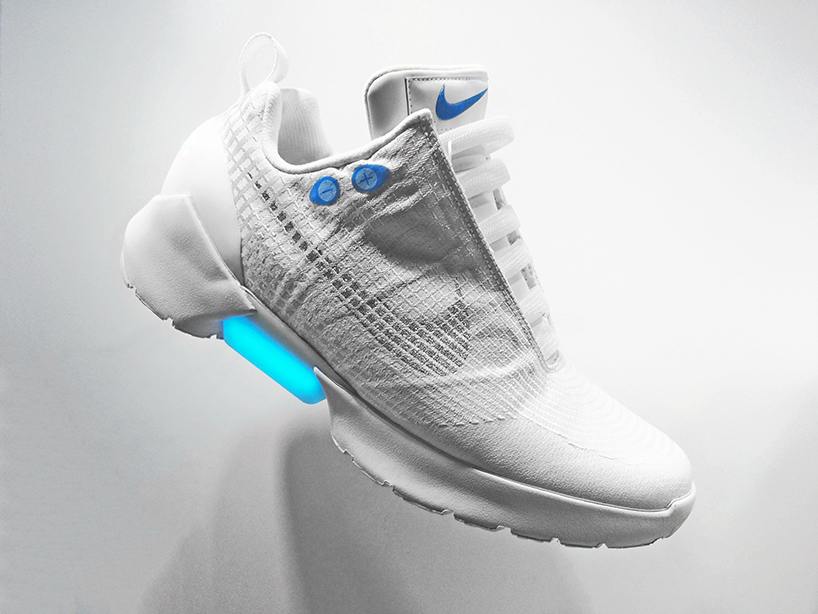
two buttons on the side of the shoe tighten and loosen the sneaker as necessary
image © designboom
DB: was there any particular input from athletes with this product?
TH: we have been prototyping for a long time, so we listen to a lot of athletes — including some well-known ones. we can hardly ever make progress without that feedback, so that’s ongoing. some of us are active and we can also do some testing. the reality is that the world’s best athletes are fast and powerful, so we try to work with the very best, and that really gives us a better idea of how well a shoe or a concept is performing. so we do it all the time.
DB: when will the ‘HyperAdapt 1.0’ be on sale?
TH: this calendar year, before the end of 2016. we are still waiting on an actual drop date, but we’re definitely shooting for the end of this year.

the NIKE ‘HyperAdapt 1.0′ will be available by the end of 2016
the sneaker was unveiled at NIKE’s innovation 2016 event in new york city, where president & CEO mark parker detailed the company’s ‘era of personalized performance’. alongside the ‘HyperAdapt 1.0’, unveils included the new NIKE+ app, an all-access pass to a wide range of coveted products and events. launching in june 2016, the app provides athletes with a personally tailored experience that connects members to the NIKE+ run club, NIKE+ training club, and NIKE+ SNKRS apps. it also offers members a personal store stocked with product recommendations and reserved invitations to their favorite sneakers.
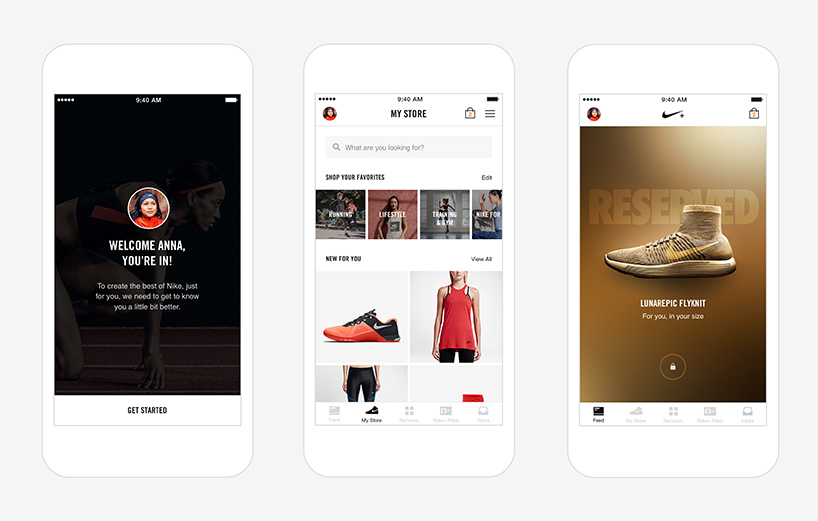
the new app provides athletes with a personally tailored experience
access begins in the customized ‘feed’ tab, which includes a continuously updated selection of stories — training tips from coaches and trainers, inspiration from athletes and information about the latest releases — tailored to each individual member. other features include: ‘my store’, a tab that showcases personalized clothing and footwear; ‘services’, a tab that connects members directly to NIKE+ experts; the ‘pass’ tab, which stores a personal QR code for use at any NIKE retail store for personal recommendations; and the ‘inbox’ tab, where members gain access to new releases and experiences.
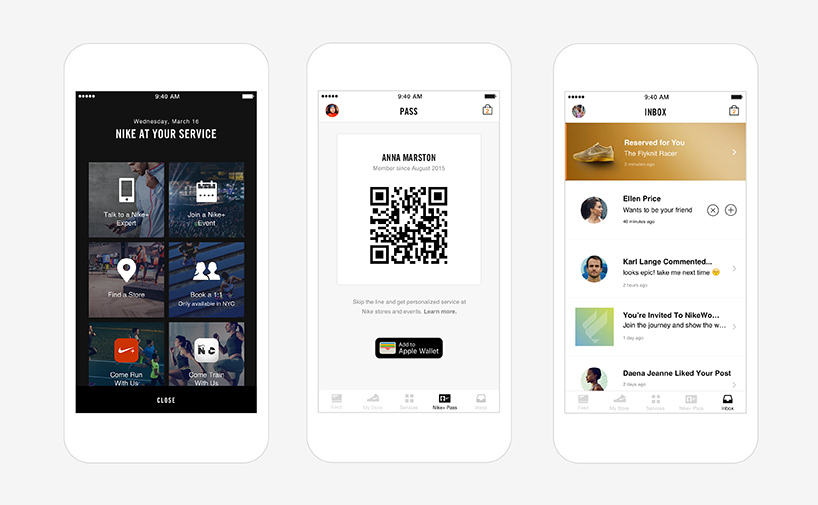
the NIKE+ app launches in june 2016
